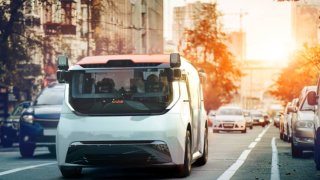
- Cruise, a majority-owned subsidiary of General Motors, has secured a new $5 billion line of credit as it prepares for commercialization of an autonomous ride-hailing business.
- The new credit is being provided by GM's automotive financing arm to use for the purchase of Cruise's self-driving Origin shuttles.
- This past month, GM began assembly of 100 pre-production Cruise Origin vehicles that will be built this summer for validation testing.
Cruise, a majority-owned subsidiary of General Motors, has secured a new $5 billion line of credit as it prepares for commercialization of its autonomous ride-hailing business.
The new credit, announced Tuesday, is being provided by GM's automotive financing arm to use for the purchase of Cruise's self-driving Origin shuttles, which GM is expected to begin producing at a factory in Detroit in early 2023. It brings Cruise's war chest to more than $10 billion, according to Cruise CEO Dan Ammann.
The Hurricane season is on. Our meteorologists are ready. Sign up for the NBC 6 Weather newsletter to get the latest forecast in your inbox.
"$10 billion. It's a big number. However, when you think about what we're building - safer, cleaner, and more accessible transportation for the world - you quickly realize it's also a necessary number," Ammann said in a blog post. "This is an incredibly exciting time for Cruise."
Ultimately, GM Finance is providing Cruise credit instead of the company attempting to raise outside capital, which it has done in the past. GM acquired Cruise in 2016. Since then, it has brought on investors such as Honda Motor, SoftBank Vision Fund and, more recently, Walmart and Microsoft.
This past month, Cruise said GM began assembly of 100 pre-production Cruise Origin vehicles that will be built this summer for validation testing.
Money Report
The Origin, which was unveiled in January 2020, is the company's first vehicle specifically designed to operate without a driver on board. It does not have manual controls such as pedals or a steering wheel.
The new credit line and pre-production model announcements follow Cruise earlier this month becoming the first autonomous vehicle developer to obtain a permit from the California Public Utilities Commission to give passengers rides in prototype robotaxis.
Commercializing autonomous vehicles has been far more challenging than many predicted even a few years ago. The challenges have led to a consolidation in the autonomous vehicle sector after years of enthusiasm touting the technology as the next multitrillion-dollar market for transportation companies.
Cruise was expected to launch a ride-hailing service for the public in San Francisco in 2019. The company delayed those plans that year to conduct further testing. It has been operating an employee ride-hailing service with a current fleet of autonomous vehicles in San Francisco for several years.






